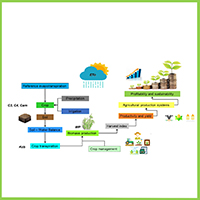Cropping pattern simulation-optimization model for water use efficiency and economic return

Published: 23 December 2021
Abstract Views: 1202
PDF: 532
HTML: 71
HTML: 71
Publisher's note
All claims expressed in this article are solely those of the authors and do not necessarily represent those of their affiliated organizations, or those of the publisher, the editors and the reviewers. Any product that may be evaluated in this article or claim that may be made by its manufacturer is not guaranteed or endorsed by the publisher.
All claims expressed in this article are solely those of the authors and do not necessarily represent those of their affiliated organizations, or those of the publisher, the editors and the reviewers. Any product that may be evaluated in this article or claim that may be made by its manufacturer is not guaranteed or endorsed by the publisher.
Similar Articles
- Ileana Blanco, Alexandros Sotirios Anifantis, Simone Pascuzzi, Giacomo Scarascia Mugnozza, Hydrogen and renewable energy sources integrated system for greenhouse heating , Journal of Agricultural Engineering: Vol. 44 No. s2 (2013): Proceedings of the 10th Conference of the Italian Society of Agricultural Engineering
- Marcello Biocca, Pietro Gallo, Paolo Menesatti, Aerodynamic properties of six organo-mineral fertiliser particles , Journal of Agricultural Engineering: Vol. 44 No. s2 (2013): Proceedings of the 10th Conference of the Italian Society of Agricultural Engineering
- R. Oberti, A. Tenca, F. Perazzolo, E. Riva, A. Finzi, E. Naldi, G. Provolo, L. Bodria, A farm-scale pilot plant for biohydrogen and biomethane production by two-stage fermentation , Journal of Agricultural Engineering: Vol. 44 No. s2 (2013): Proceedings of the 10th Conference of the Italian Society of Agricultural Engineering
- Paolo Barge, Paolo Gay, Valentina Merlino, Cristina Tortia, UHF-RFID solutions for logistics units management in the food supply chain , Journal of Agricultural Engineering: Vol. 44 No. s2 (2013): Proceedings of the 10th Conference of the Italian Society of Agricultural Engineering
- Roberto Deboli, Angela Calvo, Venerando Rapisarda, Christian Preti, Marco Inserillo, Vibration transmitted to operator’s back by machines with back-pack power unit: a case study on blower and spraying machines , Journal of Agricultural Engineering: Vol. 44 No. s2 (2013): Proceedings of the 10th Conference of the Italian Society of Agricultural Engineering
- Flavia Tauro, Andrea Petroselli, Salvatore Grimaldi, Optical sensing for stream flow observations: A review , Journal of Agricultural Engineering: Vol. 49 No. 4 (2018)
- Alessandro Biglia, Francesco Gresta, Davide Lucien Patono, Lorenzo Comba, Claudio Lovisolo, Paolo Gay, Andrea Schubert, Identification of drought-salinity combined stress in tomato plants by vegetation indices , Journal of Agricultural Engineering: Early Access
- Gian Battista Bischetti, Enrico Antonio Chiaradia, CALIBRATION OF DISTRIBUTED SHALLOW LANDSLIDE MODELS IN FORESTED LANDSCAPES , Journal of Agricultural Engineering: Vol. 41 No. 3 (2010)
- Salvatore Barbagallo, Giuseppe L. Cirelli, Alessia Marzo, Mirco Milani, Attilio Toscano, Effect of different plant species in pilot constructed wetlands for wastewater reuse in agriculture , Journal of Agricultural Engineering: Vol. 44 No. s2 (2013): Proceedings of the 10th Conference of the Italian Society of Agricultural Engineering
- Asiwan Kultongkham, Supakit Kumnon, Tawan Thintawornkul, Teeranoot Chanthasopeephan, The design of a force feedback soft gripper for tomato harvesting , Journal of Agricultural Engineering: Vol. 52 No. 1 (2021)
<< < 35 36 37 38 39 40 41 42 43 44 > >>
You may also start an advanced similarity search for this article.

 https://doi.org/10.4081/jae.2021.1197
https://doi.org/10.4081/jae.2021.1197







